Scripps Alumna Rockets into Space on Mission to Fix Hubble Telescope
Ioana Patringenaru | May 11, 2009
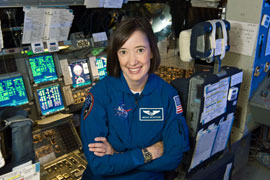
Megan McArthur poses in the shuttle simulator at the Goddard Space Flight Center in Maryland.
For as long as she can remember, Megan McArthur, an alumna of UCSD’s Scripps Institution of Oceanography, has been hanging around airplanes and interested in flying. Today, McArthur flew farther than most of us ever dreamed of, as she blasted off on the shuttle Atlantis on an 11-day repair mission to the Hubble Space Telescope.
About 100 of her former classmates, colleagues and professors at Scripps gathered at the Scripps Seaside Forum to watch McArthur realize her dream. A cheer went up as Atlantis soared into the Florida skies at 11 a.m. Then everyone seemed to hold their breath until the shuttle’s boosters detached successfully and another cheer went up.
Atlantis’ mission demonstrates why the space shuttle program is needed, said Dan Goldin, a former head of NASA and a member of Scripps’ Advisory Council who watched a live feed of the launch at Scripps. “How are you going to go service something hundreds of thousands of miles from the Earth without a way of getting there?” he asked.
McArthur bested thousands of candidates to earn her spot on this mission. She is an experienced, smart scientist, said Goldin, who signed off on McArthur appointment when he was NASA administrator. He remembers being impressed that she helped build a human-powered submarine while an undergraduate at UCLA. “Being in space is a lot like being in a sub,” he said. “If something goes wrong, you can’t go back. You better fix it.”
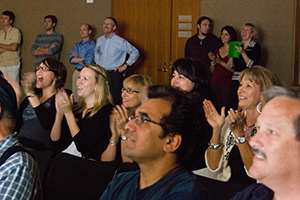
Audience members at the Scripps Seaside Forum react when Atlantis takes off.
“She’s a very bright individual,” he added.
Some of the women in the audience said they were particularly excited because they viewed McArthur as a role model who pursued her dream to become an astronaut until she made it a reality. “It’s incredible just to think that someone from Scripps who volunteered at the Birch Aquarium, is in space right now,” Jessica Crawford, a Scripps staff member, told a TV crew.
Among those who also turned out to watch Atlantis take off was Graham Kent, a Scripps research geophysicist who had been a finalist to become an astronaut, but didn’t make the cut. Asked why he wanted to witness the launch, he echoed Goldin.
“This is a prime example of work robots can’t do,” he said. “These are the two most complicated machines built by man coming together to assist each other.”
The mission
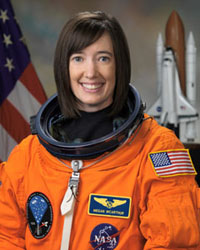
McArthur poses for her official NASA portrait. (Courtesy of NASA)
McArthur and her crewmates will be the last astronauts to work on the Hubble. For this last outing, they will not only deliver new instruments to the telescope, but also perform on-orbit surgery on older, ailing instruments—an unprecedented task, according to NASA officials.
McArthur will be in control of the shuttle’s 50-foot robotic arm. Her tasks include getting a hold of the Hubble Space Telescope and guiding it safely to the shuttle’s cargo bay. This delicate maneuver is accomplished by matching the shuttle’s speed to the telescope’s. When both are moving in concert, McArthur will extend the shuttle’s robot arm, grab onto a pin on the telescope and bring it to rest in the cargo bay. She will use a similar method to release Hubble back into space once the repairs are done.
McArthur also will carry her fellow astronauts on the end of the robotic arm, so they can do their work hands-free during space walks. In addition, she will use the arm to move large pieces of equipment, about the size of a baby grand piano or a telephone booth. She has trained countless hours for the job, according to NASA.
Risks of space travel
During this flight, the Atlantis crew also will use a 50-foot boom as an extension of the robotic arm to inspect the shuttle for damage, a new procedure put in place after the loss of the shuttle Columbia in 2003. Astronauts will look for cracks and holes in the craft’s thermal protection system.
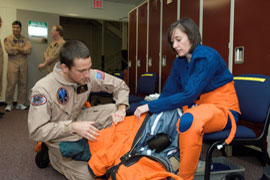
McArthur dons a training version of her shuttle launch and entry suit in preparation for a training session in the Space Vehicle Mockup Facility at Johnson Space Center. (Courtesy of NASA)
But unlike other missions that take the shuttles to the international space station, McArthur and her crewmates won’t have a safe haven to await a rescue mission if they do find critical damage on Atlantis. Instead, the shuttle Endeavour will be ready to blast off to help the stranded astronauts. The two shuttles would meet in space and Atlantis’ crew would space-walk to Endeavour, which would take the astronauts back to safety on the ground.
When asked what motivated her to shoulder the risks associated with a space mission, McArthur replied: “I think it’s important to the human spirit. It’s something that we have always done, pushed beyond the boundaries of what we know, what we can do, what we can build,” she said during a NASA interview before today’s launch.
McArthur’s trajectory
McArthur was born in Hawaii and as the daughter of a naval officer moved all over the world during her childhood, from California, to Japan, to England. She now considers California her home state because that’s where her family finally settled, according to her NASA interview.
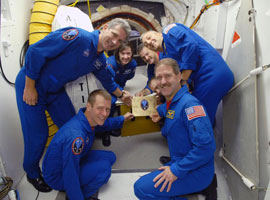
Inside the White Room on Launch Pad 39A, crew members get ready to affix the mission logo to the entrance into space shuttle Atlantis.
(Courtesy of NASA)
As a child, she remembers watching her father fly planes. Then, for several years, the family was stationed at the Moffett Field Naval Air Station, near the Ames Research Center, where astronauts would do some of their training. She used to watch them park their T-38 supersonic jets and go into training. “I thought, well, that looks like a pretty neat job,” she said. She liked the challenge of being an astronaut, she explained.
The road that led McArthur to Cape Canaveral includes a bachelor’s in aerospace engineering at UCLA and a doctorate in Applied Ocean Sciences at Scripps. The transition from space to ocean happened when McArthur signed up for UCLA’s Human Powered Submarine Races, according to the NASA interview.
She joined a team of undergraduates who were building a small two-person submarine. As the only girl, she was the only one small enough to fit in the spot designated for the submarine’s pilot. To be able to drive the sub, she had to get a scuba certification. She loved being around the ocean and decided to go to Scripps for her doctoral degree.
At Scripps
McArthur studied water acoustics at Scripps. For her thesis, she used acoustic transmissions to measure sea floor properties off Camp Pendleton. She was accepted in the NASA space program before completing her doctorate. William Hodgkiss, her doctoral thesis advisor, said he was impressed that she came back to finish her thesis after part of her training at NASA was done.
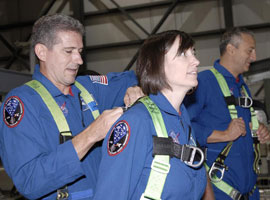
Mission Specialist Michael Good helps McArthur put on a safety harness to look inside space shuttle Atlantis' payload bay. (Courtesy of NASA)
“She had been very excited about the entire NASA space program for a long time,” he said.
At Scripps, McArthur enjoyed leaving for sea-going missions—perhaps a reflection of her desire to some day venture in space. Being in space and being on the ocean is very different, but requires a similar set of skills, Hodgkiss said. “You have to have a can-do attitude and not get overly frustrated when things don’t work out how you think they would,” he explained.
McArthur learned to plan, think through all the contingencies and execute her plans, Hoggkiss said. She also learned how to handle surprises during her missions. All these skills prepared her for a career as an astronaut, he said. “Field work was key,” he explained.
While at UCSD, McArthur also volunteered as a diver in the kelp forest at the Birch Aquarium. She is very smart, very down to earth and very caring, said Fernando Nosratpour, an assistant curator at the aquarium, who was in charge of recruiting diving volunteers at the time. When she applied to become an astronaut at NASA, he said he was glad to provide a recommendation form for her. She remained very humble through the experience, he recalls.
“It couldn’t have happened to a better person,” Nosratpour said.
After her mission, McArthur will be making an unusual contribution to the aquarium’s collections. She is taking a rock from the Scripps Oceanographic Collections with her into space. Scripps scientists collected the triangular, greenish rock from the Tonga Trench, home to the second-deepest point in the oceans and the deepest spot in the Southern Hemisphere. After Atlantis’ return, this out-of-this-world rock will be displayed in a future exhibit about the deep ocean at the Birch Aquarium.
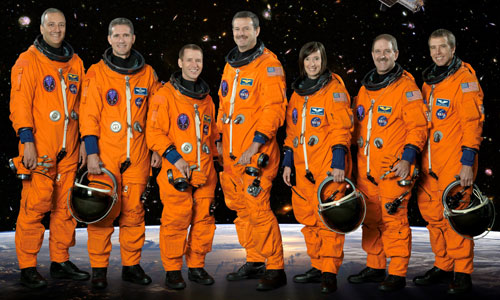
McArthur, third from right, poses with her Atlantis crewmates. (Courtesy of NASA)

|